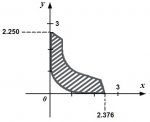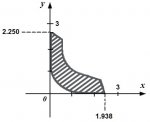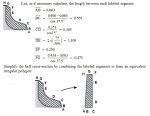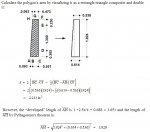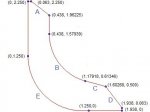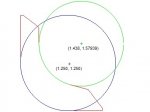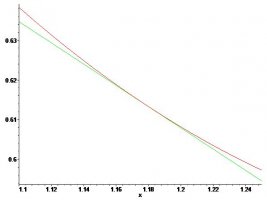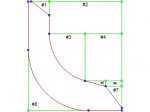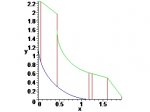Is there a method, other than summing smaller compound figures, to calculate the cross sectional area of the shell ring shown in the figure? I attempted to go around the perimeter of one-half of the shell cross section and sum up the length between points of directional change, and create an irregular polygon but the figure will not close. What am I missing here?
You are using an out of date browser. It may not display this or other websites correctly.
You should upgrade or use an alternative browser.
You should upgrade or use an alternative browser.
Area of a curved shell ring
- Thread starter rww88
- Start date
mmm4444bot
Super Moderator
- Joined
- Oct 6, 2005
- Messages
- 10,902
Yes. It's a calculus method called Integration. This method can be used to calculate the area between a curve and a horizontal axis (among other types of areas).Is there a method, other than summing smaller compound figures, to calculate the cross sectional area of the shell ring shown in the figure?
I'm not sure what your figure is that you cannot close.I attempted to go around the perimeter of one-half of the shell cross section and sum up the length between points of directional change, and create an irregular polygon but the figure will not close. What am I missing here?
I'm also not sure what this 3-d object looks like, exactly (some sort of flange ring, with a beveled hole), but I've guessed that the cross section is the light-gray shaded area (the area which appears "airbrushed") and that the areas shaded with diagonal stripes are not part of the cross section.
If this interpretation is correct, then the area you seek can be broken into a rectangle (2.624 units wide and 2.250 units high) PLUS the two areas between this rectangle and the circles with radius 1.250.
Is this project part of a class assignment? If so, what class are you taking? :cool:
D
Deleted member 4993
Guest
I think OP is looking for the volume of rotation of the hatched area( the areas shaded with diagonal stripes)Yes. It's a calculus method called Integration. This method can be used to calculate the area between a curve and a horizontal axis (among other types of areas).
I'm not sure what your figure is that you cannot close.
I'm also not sure what this 3-d object looks like, exactly (some sort of flange ring, with a beveled hole), but I've guessed that the cross section is the light-gray shaded area (the area which appears "airbrushed") and that the areas shaded with diagonal stripes are not part of the cross section.
If this interpretation is correct, then the area you seek can be broken into a rectangle (2.624 units wide and 2.250 units high) PLUS the two areas between this rectangle and the circles with radius 1.250.
Is this project part of a class assignment? If so, what class are you taking? :cool:
mmm4444bot
Super Moderator
- Joined
- Oct 6, 2005
- Messages
- 10,902
Now that you've said it, it seems clear. I think my subconscious wanted the easy way out. Ha.I think OP is looking for … areas shaded with diagonal stripes
mmm4444bot
Super Moderator
- Joined
- Oct 6, 2005
- Messages
- 10,902
Thanks for the confirmation. I'll have time tomorrow, to play with this.I am looking for the area bounded by this complex figure, with the detailed dimensions given in the first figure.
The detailed measurements make sense, to me, except for the 75° angle labeled in the smaller circle. I'm still trying to figure why its needed.
mmm4444bot
Super Moderator
- Joined
- Oct 6, 2005
- Messages
- 10,902
I'm okay on this part, now.I'm still trying to figure why [the 75° angle is] needed.
mmm4444bot
Super Moderator
- Joined
- Oct 6, 2005
- Messages
- 10,902
Regarding your second-posted diagram, I agree with the y-intercept (2.250), but I'm not getting 2.376 as the x-intercept. Did you add 0.438 twice?I am looking for the area bounded by this complex figure, with the detailed dimensions given in the first figure.
Regarding your third-posted diagram, I cannot read it. (No worries.) The image looks proportional to about 8.5 by 14 inches of information. This site reduces such large images to fit on the screen. It's better to split large images into multiple smaller images. (You can use the Preview Post button, before submitting, to see how your post will render.)
Also, I would like an answer to the following. Thank you ~ MarkBot.
MarkBot said:Is this project part of a class assignment? If so, what class are you taking?
[math]\;[/math]
Continuing . . . . .
I have corrected the x-intercept value to 1.938.
I am a free-lance technical writer currently researching the fabrication of forged fittings that are used in the branch connections of pipes. There exists very little available information on the design of these particular "creatures" as the few companies that fabricate them consider it proprietary.
Thank you for your willingness to assist.
I have corrected the x-intercept value to 1.938.
I am a free-lance technical writer currently researching the fabrication of forged fittings that are used in the branch connections of pipes. There exists very little available information on the design of these particular "creatures" as the few companies that fabricate them consider it proprietary.
Thank you for your willingness to assist.
Attachments
mmm4444bot
Super Moderator
- Joined
- Oct 6, 2005
- Messages
- 10,902
Using the shape as you have positioned it on the xy-coordinate plane, I have found:
the coordinates of 12 points of interest
the functions for 3 line segments (labeled A,C, and D)
the functions for 2 arcs (labeled B and E)
and arc B is not as circular as it may seem.
the coordinates of 12 points of interest
the functions for 3 line segments (labeled A,C, and D)
the functions for 2 arcs (labeled B and E)
and arc B is not as circular as it may seem.
Attachments
mmm4444bot
Super Moderator
- Joined
- Oct 6, 2005
- Messages
- 10,902
For line segment A, the function is:
A(x) = -0.76733*x + 2.29834
For line segment C, the function is:
C(x) = -0.26795*x + 0.92942
For line segment D, the function is:
D(x) = -1.30323*x + 2.58867
For arc B, the function is:
B(x) = 157939/100000 - 1/500*sqrt(-250000*x^2 + 719000*x - 266961)
For arc E, the function is:
E(x) = 5/4 - 1/2*sqrt(-4*x^2 + 10*x)
Tomorrow, I will determine the area of the shape in two ways. My hope is that the results match.
Method 1: Create two piecewise functions and use integration to determine the area between their graphs.
Method 2: Divide the 1.938 by 2.250 rectangle containing the shape into regions and subtract away from its area the regions not belonging to the shape
A(x) = -0.76733*x + 2.29834
For line segment C, the function is:
C(x) = -0.26795*x + 0.92942
For line segment D, the function is:
D(x) = -1.30323*x + 2.58867
For arc B, the function is:
B(x) = 157939/100000 - 1/500*sqrt(-250000*x^2 + 719000*x - 266961)
For arc E, the function is:
E(x) = 5/4 - 1/2*sqrt(-4*x^2 + 10*x)
Tomorrow, I will determine the area of the shape in two ways. My hope is that the results match.
Method 1: Create two piecewise functions and use integration to determine the area between their graphs.
Method 2: Divide the 1.938 by 2.250 rectangle containing the shape into regions and subtract away from its area the regions not belonging to the shape
Last edited:
mmm4444bot
Super Moderator
- Joined
- Oct 6, 2005
- Messages
- 10,902
My area results:
Method 1 (integration) yielded 1.631 square units
Method 2 (subtraction) yielded 1.568 square units
These results differ by 0.063 square units, which is coincidentally weird because 0.063 is one of the given linear measurements at each end of the shape.
I'd also determined the area outside arc E (to be subtracted away) as 0.33532 square units. That number is a dimension of one of the rectangular areas to be subtracted away. Weird, again!
Anyways, I was anticipating a much smaller difference between the two results, so I will revisit my calculations.
EDIT: I have updated the images in post #11 (coordinate typos) and corrected a typo in post #12 (function C has negative slope).
Method 1 (integration) yielded 1.631 square units
Method 2 (subtraction) yielded 1.568 square units
These results differ by 0.063 square units, which is coincidentally weird because 0.063 is one of the given linear measurements at each end of the shape.
I'd also determined the area outside arc E (to be subtracted away) as 0.33532 square units. That number is a dimension of one of the rectangular areas to be subtracted away. Weird, again!
Anyways, I was anticipating a much smaller difference between the two results, so I will revisit my calculations.
EDIT: I have updated the images in post #11 (coordinate typos) and corrected a typo in post #12 (function C has negative slope).
mmm4444bot
Super Moderator
- Joined
- Oct 6, 2005
- Messages
- 10,902
I found my mistake; it was function E.
I had 9/8 instead of 5/4, and I had 9x instead of 10x.
The difference in area calculations is now less than 0.0000205 square units. :cool:
The area of the shape is 1.57 square units (rounded).
I had 9/8 instead of 5/4, and I had 9x instead of 10x.
The difference in area calculations is now less than 0.0000205 square units. :cool:
The area of the shape is 1.57 square units (rounded).
D
Deleted member 4993
Guest
I am at a loss to understand why you are not taking advantage of technology in this situation?Is there a method, other than summing smaller compound figures, to calculate the cross sectional area of the shell ring shown in the figure? I attempted to go around the perimeter of one-half of the shell cross section and sum up the length between points of directional change, and create an irregular polygon but the figure will not close. What am I missing here?
If you (or your employer) are doing this type of problem more than once - try to look for a business (or university) that will have plotting tables. These tables are equipped with softwares which can measure area bounded by irregular shaped closed curves.
Thank you so much!
To mmm4444bot: Thanks so much for your assistance. I would love to the see the actual math; is that possible? I can send you my e-mail address if that would work better.
To Subhotosh Khan: I am a self-employed freelance technical writer attempting to supplement my meager retirement income through internet writing. Your kind suggestion is not feasible with my limited budget and at any rate would not applicable to this particular single-event problem. This is the primary reason I was drawn to freeMatHelp in the first place! I think it is a fantastic website.
To mmm4444bot: Thanks so much for your assistance. I would love to the see the actual math; is that possible? I can send you my e-mail address if that would work better.
To Subhotosh Khan: I am a self-employed freelance technical writer attempting to supplement my meager retirement income through internet writing. Your kind suggestion is not feasible with my limited budget and at any rate would not applicable to this particular single-event problem. This is the primary reason I was drawn to freeMatHelp in the first place! I think it is a fantastic website.
mmm4444bot
Super Moderator
- Joined
- Oct 6, 2005
- Messages
- 10,902
I'll post a summary of my steps for each method, but I don't have time to explain the calculus details. (You may look them up, if you're curious to learn about integration. EDIT: There's a link in post #20.) I'll try to do this tonight, after work.I would love to the see the actual math; is that possible?
I'm also supplementing my meager retirement income, by working part-time at a local community college (and, whenever possible, by taking advantage of bankers).
For summer quarter, they've got me in a night class (don't get home until 9:30pm).
?
mmm4444bot
Super Moderator
- Joined
- Oct 6, 2005
- Messages
- 10,902
Okay, the summary. I've assumed that you're familiar with some basic algebra. Feel free to ask about anything that's not clear. This task generally involved working with rectangles, right-triangles, and circles (along with their properties and algebraic equations).
To start, I could not determine the vertical placement of the smaller circle from the given schematic. (They don't seem to have provided any measurements for calculating it directly.) I had to solve a system of equations, to determine the y-coordinate of the smaller circle's center.
I used the following algebraic equation for circles:
(x - h)^2 + (y - k)^2 = r^2
where r is the radius and (h,k) are the coordinates at the center.
For each circle, I solved the equation for y, and I used the solution corresponding to the circle's bottom half.
I used the Point-Slope equation, for oblique lines:
y - y1 = m(x - x1)
where m is the line's slope and (x1, y1) is a known point on the line.
After substituting values for m, x1, and y1, I solved each linear equation for y.
I used trigonometry, to calculate a slope for each of the declinations given in degrees.
For example, line segment A declines 37.5° from the horizontal (negative slope).
tan(37.5°) ≈ 0.76733
Therefore, the value of m in function A(x) is -0.76733
Likewise, tan(15°) ≈ 0.26795 and tan(52.5°)≈ 1.30323, so m is -0.26795 and -1.30323 in functions C(x) and D(x), respectively.
I then used the resulting functions to find the remaining unknown coordinates. Once I had all the coordinates, I could proceed to determine the shape's area, by two methods.
(con't next post)
To start, I could not determine the vertical placement of the smaller circle from the given schematic. (They don't seem to have provided any measurements for calculating it directly.) I had to solve a system of equations, to determine the y-coordinate of the smaller circle's center.
I used the following algebraic equation for circles:
(x - h)^2 + (y - k)^2 = r^2
where r is the radius and (h,k) are the coordinates at the center.
For each circle, I solved the equation for y, and I used the solution corresponding to the circle's bottom half.
I used the Point-Slope equation, for oblique lines:
y - y1 = m(x - x1)
where m is the line's slope and (x1, y1) is a known point on the line.
After substituting values for m, x1, and y1, I solved each linear equation for y.
I used trigonometry, to calculate a slope for each of the declinations given in degrees.
For example, line segment A declines 37.5° from the horizontal (negative slope).
tan(37.5°) ≈ 0.76733
Therefore, the value of m in function A(x) is -0.76733
Likewise, tan(15°) ≈ 0.26795 and tan(52.5°)≈ 1.30323, so m is -0.26795 and -1.30323 in functions C(x) and D(x), respectively.
I then used the resulting functions to find the remaining unknown coordinates. Once I had all the coordinates, I could proceed to determine the shape's area, by two methods.
(con't next post)
mmm4444bot
Super Moderator
- Joined
- Oct 6, 2005
- Messages
- 10,902
The method of subtraction is fairly straightforward. I enclosed the shape in a 1.938 by 2.25 rectangle, and then used the known points to divide the area above and to the right of the shape into rectangles, right-triangles, and half a circular segment; the area below the left part of the shape is labeled as region #8, in the image below.
The areas of these eight individual regions can be easily calculated. I simply subtracted these areas from the area of the 1.938 by 2.25 rectangle. What remained is the area sought.
Region #3 is half of a segment of the smaller circle. There is a trigonometric formula (among others) for the area of a circular segment, when you know the radius and the segment width:
Areasegment = r^2*arccos([r-w]/r) - (r-w)*sqrt(2*r*w - w^2)
where r is the circle radius, w is the segment width, and the inverse cosine function outputs the angle in radians.
Using r = 1 and w = 0.74118, this formula gives about 1.058995 as the segment's area. Region #3 represents half the circular segment, so the area of region #3 is about 0.529498 square units.
Region #8 is part of the area between a circle and a square. That is, if we inscribe a circle with radius 1.25 inside a 2.5 by 2.5 square, then region #8 is one-fourth the difference between the square's area and the circle's area.
The remaining regions are rectangles and right-triangles, whose dimensions can be determined from the known points.
I'm sure you remember:
Arearectangle = Length*Width
Areatriangle = 1/2*Base*Height
(con't next post)
The areas of these eight individual regions can be easily calculated. I simply subtracted these areas from the area of the 1.938 by 2.25 rectangle. What remained is the area sought.
Region #3 is half of a segment of the smaller circle. There is a trigonometric formula (among others) for the area of a circular segment, when you know the radius and the segment width:
Areasegment = r^2*arccos([r-w]/r) - (r-w)*sqrt(2*r*w - w^2)
where r is the circle radius, w is the segment width, and the inverse cosine function outputs the angle in radians.
Using r = 1 and w = 0.74118, this formula gives about 1.058995 as the segment's area. Region #3 represents half the circular segment, so the area of region #3 is about 0.529498 square units.
Region #8 is part of the area between a circle and a square. That is, if we inscribe a circle with radius 1.25 inside a 2.5 by 2.5 square, then region #8 is one-fourth the difference between the square's area and the circle's area.
The remaining regions are rectangles and right-triangles, whose dimensions can be determined from the known points.
I'm sure you remember:
Arearectangle = Length*Width
Areatriangle = 1/2*Base*Height
(con't next post)
Attachments
Last edited:
mmm4444bot
Super Moderator
- Joined
- Oct 6, 2005
- Messages
- 10,902
The method of integration comes from calculus.
In general, if you have two well-behaved functions, and you'd like to know an area between their graphs, integration will do it.
I had already determined the functions needed, and I used a CAS (computer algebra system) to complete each integral's "number-crunching" for me. (I'm lazy.)
Pieces of functions A(x), B(x), C(x), D(x), and F(x)=2.25 can be spliced together, to form the "top" boundary of the shape.
Pieces of functions E(x) and G(x)=0 can be spliced together, to form the "bottom" boundary of the shape.
Basically, we're filling in the shape with an infinite number of vertical "slices", and integration provides the means to sum up these many slices' areas, to get a total area. (You may think of each slice as simply a vertical line segment, with infinitely-thin width.)
We get the height of each slice by taking the difference between the top function value and the bottom function value, and integration does this at each x (from left to right) over the interval from x=0 to x=1.938.
In the image below, there are points along both the top (green) and bottom (blue) boundaries where the respective piece-wise functions change (eg: from A(x) to B(x) on top, from E(x) to G(x) on bottom) . This necessitates having to integrate over sub-intervals (red). We add up the results.
\(\displaystyle \displaystyle \int_{0}^{0.063} \! 2.25\!-\!E(x) \; \mathrm{d}x = 0.07954\)
\(\displaystyle \displaystyle \int_{0.063}^{0.438} \! A(x)\!-\!E(x) \; \mathrm{d}x = 0.59346\)
\(\displaystyle \displaystyle \int_{0.438}^{1.179} \! B(x)\!-\!E(x) \; \mathrm{d}x = 0.564391\)
\(\displaystyle \displaystyle \int_{1.179}^{1.250} \! C(x)\!-\!E(x) \; \mathrm{d}x = 0.04273\)
\(\displaystyle \displaystyle \int_{1.250}^{1.603} \! C(x) \; \mathrm{d}x = 0.19300\)
\(\displaystyle \displaystyle \int_{1.603}^{1.938} \! D(x) \; \mathrm{d}x = 0.09439\)
I hope that my hastily-written summary is helpful. :cool:
In general, if you have two well-behaved functions, and you'd like to know an area between their graphs, integration will do it.
I had already determined the functions needed, and I used a CAS (computer algebra system) to complete each integral's "number-crunching" for me. (I'm lazy.)
Pieces of functions A(x), B(x), C(x), D(x), and F(x)=2.25 can be spliced together, to form the "top" boundary of the shape.
Pieces of functions E(x) and G(x)=0 can be spliced together, to form the "bottom" boundary of the shape.
Basically, we're filling in the shape with an infinite number of vertical "slices", and integration provides the means to sum up these many slices' areas, to get a total area. (You may think of each slice as simply a vertical line segment, with infinitely-thin width.)
We get the height of each slice by taking the difference between the top function value and the bottom function value, and integration does this at each x (from left to right) over the interval from x=0 to x=1.938.
In the image below, there are points along both the top (green) and bottom (blue) boundaries where the respective piece-wise functions change (eg: from A(x) to B(x) on top, from E(x) to G(x) on bottom) . This necessitates having to integrate over sub-intervals (red). We add up the results.
\(\displaystyle \displaystyle \int_{0}^{0.063} \! 2.25\!-\!E(x) \; \mathrm{d}x = 0.07954\)
\(\displaystyle \displaystyle \int_{0.063}^{0.438} \! A(x)\!-\!E(x) \; \mathrm{d}x = 0.59346\)
\(\displaystyle \displaystyle \int_{0.438}^{1.179} \! B(x)\!-\!E(x) \; \mathrm{d}x = 0.564391\)
\(\displaystyle \displaystyle \int_{1.179}^{1.250} \! C(x)\!-\!E(x) \; \mathrm{d}x = 0.04273\)
\(\displaystyle \displaystyle \int_{1.250}^{1.603} \! C(x) \; \mathrm{d}x = 0.19300\)
\(\displaystyle \displaystyle \int_{1.603}^{1.938} \! D(x) \; \mathrm{d}x = 0.09439\)
I hope that my hastily-written summary is helpful. :cool:
Attachments
Last edited:


